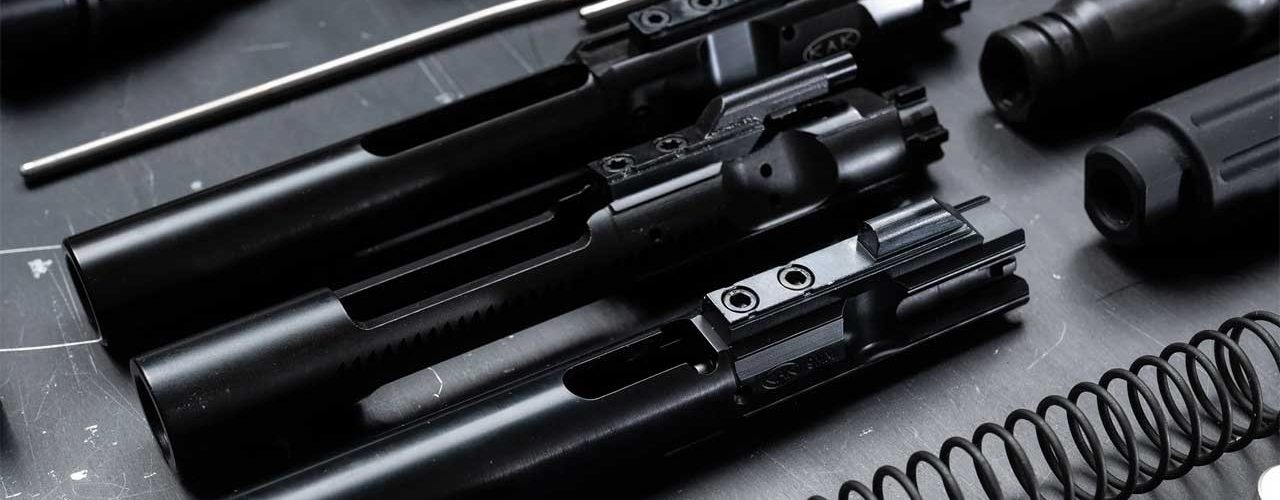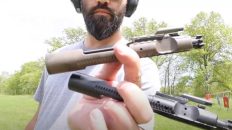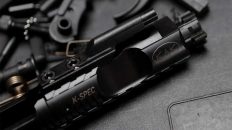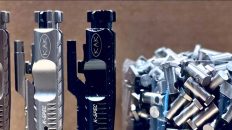If you’ve ever dived into the world of firearms, you’ll know that bolt carriers play a crucial role in how they function. These seemingly innocuous components are responsible for chambering a round, extracting and ejecting spent casings, and preparing the firearm for the next round. But what exactly are bolt carriers, and how do they work?
In this comprehensive guide, we’ll explore everything you need to know about bolt carriers and their role in firearms. From understanding the different types of bolt carriers to learning about the materials used in their construction, we’ll leave no stone unturned. Whether you’re a seasoned gun enthusiast looking to expand your knowledge or a beginner seeking a fundamental understanding, this guide is for you.
Join us as we break down the inner workings of bolt carriers, demystify firearm jargon, and provide practical insights to help you make informed decisions when it comes to firearms. Get ready to unlock a deeper understanding of these essential AR-15 components, and enhance your appreciation for the intricate mechanics behind your favorite firearms.
Functions and components of a bolt carrier
At the heart of any firearm’s action lies the bolt carrier, a critical component responsible for the smooth and reliable cycling of the firearm. The bolt carrier group, which includes the bolt carrier, bolt, and associated BCG parts, is housed within the upper receiver, enabling the loading, firing, extraction, and ejection of cartridges.
The primary functions of a bolt carrier are to chamber a round, lock the bolt in place during firing, extract the spent casing, and prepare the firearm for the next shot. It achieves this by housing the bolt, which is the component that directly interacts with the cartridge. The bolt carrier group is responsible for the cyclic operation of the firearm, ensuring a seamless transition from one shot to the next.
The key components of a bolt carrier include the carrier body, the bolt, the firing pin, the cam pin, and the gas key. The carrier body is the main structure that houses the other components and facilitates the movement of the bolt. The bolt is the part that engages with the chamber and locks the round in place. The firing pin strikes the primer to ignite the propellant, while the cam pin ensures the proper rotation and locking of the bolt. The gas key is a crucial element that channels the high-pressure gas from the barrel into the carrier, providing the necessary energy to cycle the action.
Different types of bolt carriers
Bolt carriers come in a variety of designs, each optimized for specific applications or user preferences. The most common types of bolt carriers include the full-auto, semi-auto, and lightweight variants.
The full-auto bolt carrier is designed for use in automatic or select-fire firearms, such as military-grade assault rifles. This type of carrier is engineered to withstand the high cyclic rates and increased stresses associated with full-auto fire. Full-auto bolt carriers typically feature a more robust construction and may have additional features like a wider gas key or a heavier overall design.
The semi-auto bolt carrier, on the other hand, is tailored for use in semi-automatic firearms, where each trigger pull results in a single shot. These carriers are often lighter and more streamlined, as they do not need to handle the same level of stress as their full-auto counterparts. Semi-auto bolt carriers are commonly found in civilian-legal rifles and carbines.
Lightweight bolt carriers are a specialized design that prioritizes reduced weight without sacrificing functionality. These carriers are popular among shooters who value enhanced handling characteristics, particularly in AR-platform rifles. The weight reduction is achieved through the use of specialized materials, such as aluminum or titanium, or by removing certain non-essential features. Lightweight bolt carriers can improve the overall balance and maneuverability of the firearm, making them a popular choice for competition shooters and recreational users.
Materials used in bolt carriers
The materials used in the construction of bolt carriers play a crucial role in their performance, durability, and longevity. The most commonly used materials for bolt carriers include steel, aluminum, and titanium.
Steel is the traditional and most widely used material for bolt carriers. It offers excellent strength, rigidity, and wear resistance, making it a reliable choice for a wide range of firearms. Steel bolt carriers are known for their ability to withstand the high pressures and stresses of the firing cycle. They are typically the most cost-effective option and are commonly found in military and law enforcement-grade firearms.
Aluminum bolt carriers, on the other hand, provide a significant weight reduction compared to their steel counterparts. Aluminum is a lightweight, yet durable material that can offer a substantial decrease in the overall weight of the firearm. This reduction in weight can improve handling and reduce shooter fatigue, particularly in prolonged use. Aluminum bolt carriers are popular among civilian shooters and competition enthusiasts who prioritize agility and maneuverability.
Titanium bolt carriers represent the cutting edge in bolt carrier design. Titanium is an exceptionally strong and lightweight material that offers an exceptional strength-to-weight ratio. Titanium bolt carriers are prized for their exceptional durability, corrosion resistance, and the ability to withstand the rigors of high-stress environments. While more expensive than steel or aluminum, titanium bolt carriers are favored by discerning shooters who demand the highest level of performance and reliability from their firearms.
The role of bolt carriers in firearm operation
The bolt carrier is the heart of a firearm’s action, responsible for the seamless and reliable cycling of the firearm. Its role in the overall operation of a firearm is critical, as it directly impacts the firearm’s performance, accuracy, and safety.
When a round is fired, the high-pressure gases generated by the ignition of the propellant are channeled through the gas system, which in turn drives the bolt carrier group rearward. This rearward movement extracts the spent casing from the chamber and ejects it from the firearm. As the bolt carrier group reaches the rear of its travel, the recoil spring pushes it forward, stripping a new round from the magazine and chambering it. The bolt then locks into the barrel extension, securing the cartridge in place and preparing the firearm for the next shot.
The precise timing and coordination of these actions are essential for the reliable and consistent operation of a firearm. The bolt carrier group must be designed and engineered to withstand the tremendous forces and stresses generated during the firing cycle within upper receivers, ensuring that the firearm functions flawlessly shot after shot.
The design and materials used in the construction of the bolt carrier can have a significant impact on the overall performance of the firearm. A well-designed and properly maintained bolt carrier can contribute to improved accuracy, reduced felt recoil, and enhanced reliability, even in the most demanding environments. Conversely, a poorly designed or worn-out bolt carrier can lead to malfunctions, decreased accuracy, and potentially dangerous situations.
Factors to consider when choosing a bolt carrier
When selecting a bolt carrier for your firearm, there are several key factors to consider to ensure you choose the right component for your needs. These factors include the intended use of the firearm, the materials used in the bolt carrier’s construction, the carrier’s weight, and any specific features or modifications.
The intended use of the firearm is a primary consideration when choosing a bolt carrier. If you plan to use your firearm in a high-stress, high-round-count environment, such as competition shooting or military/law enforcement applications, you’ll want to opt for a more robust and durable bolt carrier, such as a full-auto or heavy-duty design. Conversely, if your firearm is primarily used for recreational or light-duty purposes, a semi-auto or lightweight carrier may be a more appropriate choice.
The materials used in the bolt carrier’s construction are also crucial. As discussed earlier, steel, aluminum, and titanium are the most common options, each with its own advantages and trade-offs. Steel bolt carriers offer exceptional strength and durability, while aluminum provides a weight reduction, and titanium delivers an unparalleled strength-to-weight ratio. Carefully consider the specific needs of your firearm and your personal preferences to determine the best material for your application.
The weight of the bolt carrier is another important factor. Heavier carriers can contribute to increased recoil and a slower rate of fire, while lighter carriers can improve handling and responsiveness. For some shooters, the reduced weight of a lightweight carrier may be a priority, while others may prefer the added stability and control of a heavier design. Consider your shooting style, the type of firearm, and your personal preferences to make the best choice.
Finally, be mindful of any specific features or modifications you may require in a bolt carrier. Some carriers come with enhanced gas keys, additional lubrication channels, or other specialized features that can be tailored to your needs. Carefully research the available options and select the bolt carrier that best fits your firearm and shooting requirements.
Maintenance and cleaning of bolt carriers
Proper maintenance and cleaning of the bolt carrier are essential for ensuring the reliable and consistent operation of a firearm. Neglecting the care of this critical component can lead to malfunctions, decreased accuracy, and even potentially dangerous situations.
The first step in maintaining a bolt carrier is to keep it clean and well-lubricated. Regular cleaning and inspection of the carrier, bolt, and associated AR-15 parts should be a routine part of your firearm maintenance regimen. Begin by disassembling the bolt carrier group, carefully removing any dirt, carbon buildup, or debris that may have accumulated. Use a high-quality solvent and a soft-bristle brush to thoroughly clean all surfaces, paying special attention to the gas key, cam pin, and firing pin.
After cleaning, it’s important to properly lubricate the bolt carrier and its components. Apply a thin, even coat of a high-quality firearm lubricant to all moving parts, ensuring that the carrier, bolt, and other surfaces are well-protected. Avoid over-lubrication, as excess oil can attract additional dirt and debris, leading to potential malfunctions.
Regular inspection of the bolt carrier is also crucial. Look for any signs of wear, cracks, or damage, such as excessive wear on the cam path or gas key. If any issues are identified, it’s important to address them promptly to prevent further degradation and potential failure. In some cases, replacement of the bolt carrier or specific components may be necessary to maintain the firearm’s reliability and performance.
By following a consistent maintenance routine and addressing any issues as they arise, you can ensure that your bolt carrier remains in optimal condition, contributing to the overall reliability and longevity of your firearm.
For a more detailed guide, check out our article on how to clean a bolt carrier group.
Upgrades and modifications for bolt carriers
As with many firearm components, there are a variety of upgrades and modifications available for bolt carriers to enhance their performance and functionality. These enhancements can cater to the specific needs and preferences of individual shooters, whether they are seeking improved reliability, increased accuracy, or a more customized aesthetic.
One popular upgrade for bolt carriers is the addition of a lightweight design. As mentioned earlier, lightweight bolt carriers, often made from materials like aluminum or titanium, can significantly reduce the overall weight of the firearm, improving handling and reducing shooter fatigue. This can be particularly beneficial for competition shooters or those who engage in frequent, prolonged shooting sessions.
Another common modification is the incorporation of enhanced gas keys. The gas key is responsible for channeling the high-pressure gas from the barrel into the bolt carrier, providing the necessary energy to cycle the action. Upgrading the gas key with a more robust design can improve reliability and consistency, particularly in high-stress environments or when using non-standard ammunition.
Shooters who prioritize customization may opt for bolt carriers with specialized coatings or finishes. These can range from durable, corrosion-resistant treatments to unique, eye-catching designs that complement the overall aesthetic of the firearm. While these modifications are primarily cosmetic, they can contribute to a shooter’s personal style and sense of ownership.
In addition to these upgrades, some shooters may choose to modify the carrier’s internal components, such as the cam pin or firing pin, to further optimize the firearm’s performance. These more advanced modifications should be undertaken with caution and a thorough understanding of the potential risks and consequences, as they can have a significant impact on the firearm’s safety and reliability.
Regardless of the specific upgrades or modifications chosen, it’s crucial to ensure that any changes to the bolt carrier are compatible with the firearm’s design and are installed by a qualified gunsmith or with the appropriate gunsmithing tools and expertise.
Common issues and troubleshooting with bolt carriers
Despite their essential role in firearm operation, bolt carriers can occasionally encounter issues that can impact the overall performance and reliability of the weapon. Understanding these common problems and how to troubleshoot them can help you maintain your firearm in peak condition.
One of the most common issues with bolt carriers is excessive wear or damage. Over time, the constant cycling and high stresses can take a toll on the carrier, leading to accelerated wear on the cam path, gas key, or other critical surfaces. This can result in malfunctions, such as failure to extract or eject spent casings, or even a complete failure of the action. Regularly inspecting the bolt carrier for signs of wear and replacing it if necessary is crucial to maintaining reliable operation.
Another potential issue is improper lubrication or contamination of the bolt carrier. If the carrier is not sufficiently lubricated or becomes fouled with dirt, carbon buildup, or other debris, it can lead to increased friction, binding, and ultimately, malfunctions. Diligent cleaning and proper application of a high-quality firearm lubricant can help mitigate these problems.
In some cases, the bolt carrier may not be properly matched to the specific firearm or ammunition being used. Mismatched components or the use of non-standard ammunition can cause cycling issues, such as failure to fully cycle or excessive recoil. Ensuring that the bolt carrier is compatible with the firearm and ammunition is essential for reliable performance.
If you encounter any issues with your bolt carrier, it’s important to troubleshoot the problem methodically. Start by thoroughly cleaning and inspecting the carrier, checking for any signs of wear or damage. If the issue persists, consider replacing the carrier or consulting a qualified gunsmith for further diagnosis and repair.
By understanding the common problems associated with bolt carriers and taking proactive steps to maintain and troubleshoot them, you can help ensure the long-term reliability and performance of your firearm.
Conclusion: Importance of a quality bolt carrier in firearm performance
In the world of firearms, the bolt carrier is a critical component that plays a pivotal role in the overall performance and reliability of a firearm. As we’ve explored in this comprehensive guide, the bolt carrier is responsible for the smooth and consistent cycling of the action, ensuring that each shot is fired with precision and dependability.
Whether you’re a seasoned gun enthusiast or a newcomer to the world of firearms, understanding the functions, materials, and maintenance of bolt carriers is essential for making informed decisions about your firearm’s components. By selecting the right bolt carrier for your specific needs and keeping it well-maintained, you can unlock the full potential of your firearm, enjoying enhanced accuracy, reduced recoil, and reliable operation, even in the most demanding environments.
As you continue your journey into the world of firearms, remember the critical role that the bolt carrier plays in the overall performance of your firearm. By prioritizing the quality and care of this essential component, you’ll not only ensure the longevity and reliability of your firearm but also deepen your appreciation for the intricate mechanics that make it function. So, the next time you pick up your firearm, take a moment to reflect on the unsung hero that is the bolt carrier, and the vital role it plays in your shooting experience.
For a more comprehensive guide, check out our article on what is a bolt carrier group?





Add comment